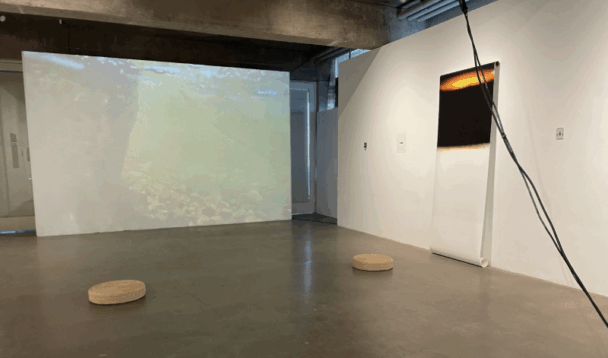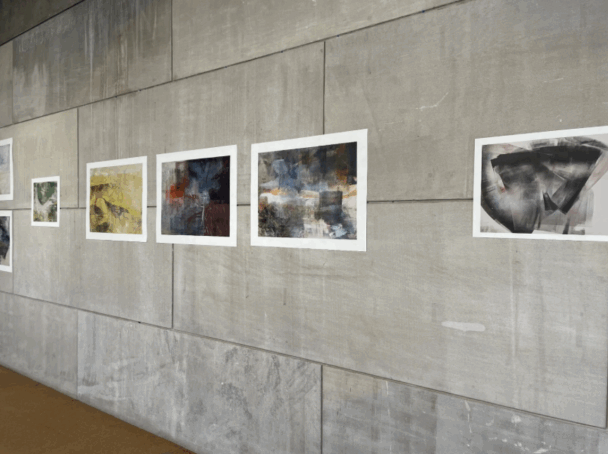
The third week of the University’s 2025 art studio senior thesis exhibitions opened Wednesday, April 9, 2025 at the Ezra and Cecile Zilkha Gallery, hosting eight distinct bodies of work from Kerri Bel ’25, Beatrice Campomori Garuti ’25, Olivia Gomez ’25, Vicky Gong ’25, Will Hardison ’25, Aleah Hurwitz ’25, Ava Liberace ’25, and Alp Yücel ’25.
The showcase moved between mediums and moods, going from fantastical world-building to fragmented memory, from archival play to tactile material investigation. While not every artist was available for comment, The Argus was able to speak directly with a few of the exhibiting seniors, whose reflections provide an intimate look into their creative processes and personal motivations.
In a room adjacent to the entrance to the gallery, I first viewed Gong’s thesis, entitled “Ether.” Drawing on inspiration from the phenomena of death, the psyche, and the camera, and engaging with Flusser’s notion of the apparatus, Gong explored the tension between intimacy and alienation through an intricate interplay of material, affect, and technology.
“[The project investigates] the device within ecologies of image, control, and affect,” Gong wrote in an email to The Argus. “[Emphasizing how] material-semiotic entanglements produce conditions of legibility, and estrangement…There’s a tension between intimacy and alienation in that relationship that I hope comes through.”
Gong shared this perspective in hopes of inviting viewers to connect the themes and materials in a way that reflects their own entanglements with technology. Their exhibition also took on new meaning when they broke a critical glass component during installation.
“I ran out to buy new glass, made a new one, and struggled with whether it still felt like the original piece—and whether I should hide what happened,” Gong wrote. “In that hesitation, in that small catastrophe, I understood something. The fragility of it all.”
This moment encapsulates the essence of Gong’s work, which acknowledges fragility and embraces the process of transformation and exploration.
While Gong’s work dwelled in the tension of technology, at the front of the gallery, Hardison’s thesis “The Sand Remembers the Waves” transformed the angular, light-filled architecture of the space into a quiet kelp forest. Responding initially to the landscapes of California, Hardison created a monotype series that explores memory through repeatedly printed scenes, reflecting the way impressions change over time. As he continued his work, Hardison pivoted from focusing on imagery to emphasizing form.

“I kept asking myself why I was using printmaking instead of painting to create this project,” Hardison wrote in an email to The Argus. “Monotype is a form of printmaking where the final result is one of one. This is very contradictory to the essence of printmaking—to make many copies. So monotype is all about exploring textures, movement, and effects that you cannot recreate in any other medium.”
The result was a fluid interaction between image and space, where the viewer, like a swimmer or wanderer, passed through a memory of the coast.
Suspended in the center of the gallery, Yücel’s thesis entitled “Obstructed View” stood out for its striking design. The artwork, which was constructed from fir wood, aluminum, and steel, played with visual perception and physical obstruction.
“I was drawn to how sometimes obstructed views make things more beautiful,” Yücel wrote in an email to The Argus. “There’s something pretty about only being able to partially see.”

What began as simple window-frame-like structures evolved into complex sculptural installations that invited viewers to shift position and perspective. Yücel hoped to challenge expectations both in terms of how the eye sees and how the body moves through the gallery.
“I wanted to make something that people would say, ‘how the fuck did you hang that?’” Yücel wrote in an email to The Argus, noting the logistical nightmare of getting his piece through the gallery doors. “Those fucking gallery doors, man… two inches off.”
Down the gallery, Hurwitz’s thesis, entitled “Abiding by the Institution,” offered a visually stark critique of labor and institutionality, inspired in part by their experience as a rower and by post-conceptual sculpture. Working with found structures originally created by past thesis artist Tommy Graves ’23, Hurwitz adhered paper to cellophane-wrapped metal rods that match the dimensions of the Center for the Arts.
“I was thinking about Andy Warhol when I began,” Hurwitz wrote in an email to The Argus. “He worked with silkscreen printing to allude to machine processes. I was interested in his idea of becoming a machine, which coincides with rowing for me.”
As the project developed, their influences shifted to Robert Morris’ “L-Beams” and the interaction with sculpture. Using industrial spray glue and printmaking techniques, she constructed a deliberate yet fragile architecture that gestured directly toward the institution both as a physical space and as a conceptual structure.
As a whole, week three of the senior exhibitions kept the energy going with a show that felt both thoughtful and bold. From challenging institutions to exploring beauty in unexpected ways, each artist brought something personal to the space, leaving work behind that lingered long after you stepped outside Zilkha.
Stella Loezos can be reached at sloezos@wesleyan.edu.



Leave a Reply